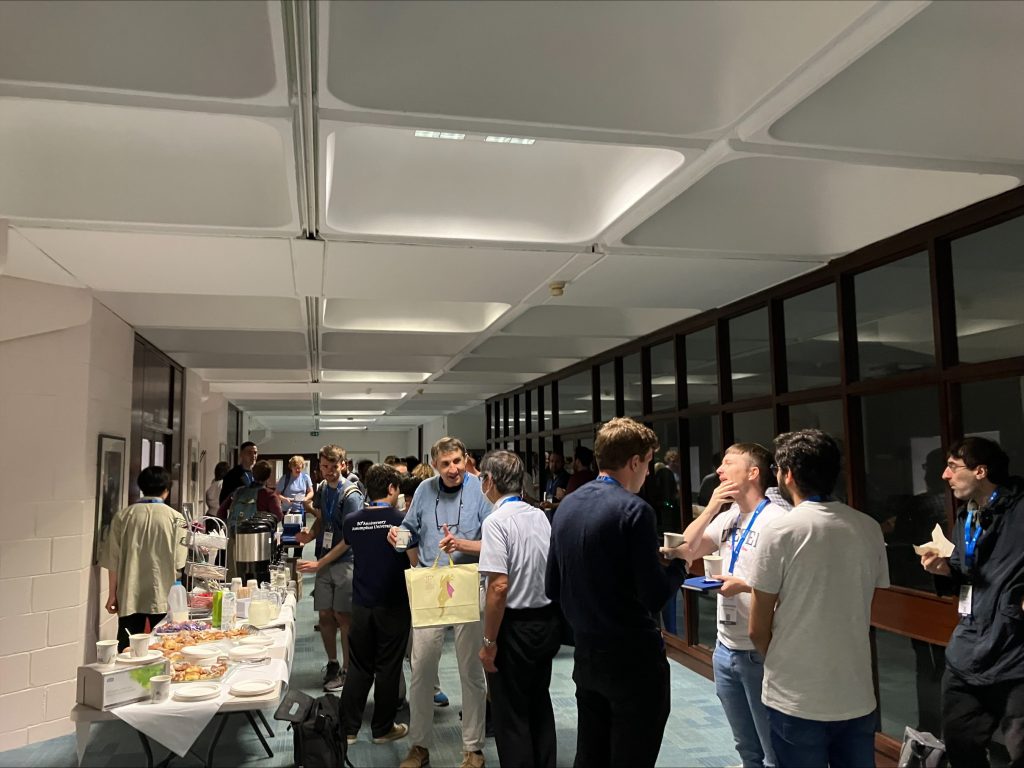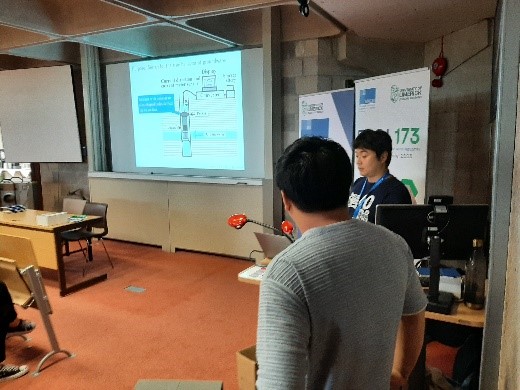European Study Group Workshop with Industry: ESGI173 Report
Participation in the Study Group European Study Group with Industry (ESGI 173) in Ireland
FUKUMOTO Yasuhide, Professor, The Institute of Mathematics for Industry
From June 19-23, 2023, I participated in the European Study Group Workshop with Associate Professor Pierluigi Cesana and students of the JGMI at the University of Limerick in Limerick, located in the southwest of mid-Ireland. The seven students who participated in the study group were, in order of seniority, YANG Man, KAWAMO Eitaro, KIURA Kazuya, TAJIMA Ryota, YOSHIZUMI Shun, HIGUMA Toshihide, and YAMADA Hidenori.
This event, started by Professor John Ockendon (Oxford University) in 1968, concentrates on unsolved problems in industry, and has spread around the world, but as is evident from the 173 times it has been held, it is thriving in Europe, where it is held several times a year, rotating among leading universities in each country. The more than 60~70 participants included quite a few regulars (repeaters). There were also participants from New Zealand and Australia. Many young local researchers and graduate students also attended. The name Limerick brings to mind the classic five-line poem enjoyed in England, but the relationship with the name of the place is not clear (although there may be some connection). Located on the banks of the Shannon River, the sprawling campus is lush with water and greenery, and with a theater in the center, it provides a relaxed environment in which to study and research. The University of Limerick is strong in industrial mathematics, and this is the second time ESGI has been held here. Incidentally, in the 2022 World Competitiveness Yearbook by the IMD (International Institute for Management Development), Ireland is ranked 11th after the United States, while Japan is ranked 34th.
In early spring, I was invited to join this study group by Professor Michael Vynnycky (University of Limerick), who was invited to Kyushu University in July 2022 to give a seminar lecture under the GPMI (Program conducted by JSPS) in Japan, and I decided to join immediately because of my interest in Ireland, where Hamilton and Stokes were born. After receiving a proposal from Osamu Saeki, Program Coordinator of the GPMI, I approached him about the participation of students from the JGMI, and he readily accepted. Sometime later, Professor Vynnycky asked me to provide a problem. I contacted researchers from geotechnical companies, and Mr. Masanori Murai (Shimizu Corporation) and Mr. Takayuki Tsuzuki (Nippon Geophysical Mining Co., Ltd.) gave me a problem that has long been faced by the Geothermal Research Society, which works across companies: the optimal design of observation holes for strainers for groundwater measurement. In Japan, since the 1990s, a method has been used to measure groundwater flow velocity by inserting a cylinder with a temperature sensor deep underground and determining the flow velocity based on the deviation of the temperature distribution, but this method has suffered from the phenomenon that the flow velocity is not correctly reflected in the temperature distribution at a certain rate.
The five challenges (Industry Challenges) were gathered at ESGI 173.
1. Unlocking energy efficient steelmaking by robust scrap melting.
2. Controlling flow rate in infusion pumps.
3. Optimal design of observation holes on strainers for groundwater measurements.
4. Proof-of-concept model for demand prediction for EV charging.
5. Manufacture of contact lenses.
Issue 3 is from Kyushu University, but the others have Irish colors. Issue 2 comes from Becton Dickinson, a global medical technology company, which has recently established a research site in Limerick. Issue 5 comes from an Irish contact lens manufacturing company.
On the first day, Monday morning, after a 30-minute explanation per assignment, the group broke into rooms to work on each assignment in the afternoon. Mr. KAWAMO and Mr. HINOKUMA worked on Issue 2, “Blood Transfusion Pump Control,” Mr. KIURA, Mr. TAJIMA, Associate Professor Cesana and I worked on Issue 3, “Measurement of Groundwater Flow,” and Mr. YANG, Mr. YOSHIZUMI and Mr. YAMADA worked on Issue 4, “EV Charging Demand Prediction. The students enjoyed themselves and worked hard for four days.

In Issue 2, they found a statistical model that fits the given time series data and contributed to the analysis of the flow rate error of infusion pumps. In Issue 4, they proposed a way to quantitatively express the relationship between the amount of traffic on the road and the location of the chargers using graph theory. In Issue 3, guided by Professor Vynncyky, students used harmonic functions to calculate pressure distributions from which they derived groundwater velocities, and Associate Professor Cesana used stochastic models to try to explain how false data can appear. The last Friday of the workshop was the presentation of the results. Figure 2 shows one of the presentations. Actually, I only participated in the first three days and attended the presentation from the Netherlands via Zoom. It seems that the students learned how discussions with researchers from different backgrounds can be effective in solving problems through their experiences.

ESGI, which has been in existence for more than half a century, follows a strict format for its operations.
The most difficult task for the management is to raise funds for the event, and a fee of 10,000 euros (approximately 1.5 million yen) per proposal is collected from the companies and organizations that provide the proposals. This covers breakfast, lunch, and dinner for the participants for five days, coffee and pastries, and accommodation in campus dormitories. This time, beer coupons were given out each evening, so that we could quench our thirst with a good black beer (probably Guinness) after a day’s work. It may be a small expense for one company, but they would not give out this much money for nothing in return. It is likely that this is due in large part to the fact that mathematics and mathematical science researchers have accumulated results at past ESGIs and won the trust of many companies. This is the homework for Japan’s Study Group, which has been sponsored by IMI every year since 2010.
For Issue 3, questions from the audience were forwarded to Japan via e-mail on the spot. Even though it was early in the morning, Dr. TAKEUCHI Atsuo (Kyoto University), Mr. TSUZUKI Takayuki, and Mr. MURAI Masanori were on standby and replied with detailed answers and supplementary materials in no time.
The provision fee for Issue 3 was supported by the IMI’s Mission Realization Acceleration Fund, which was provided by the Ministry of Education, Culture, Sports, Science and Technology of Japan (MEXT). We would like to take this opportunity to express our gratitude.

